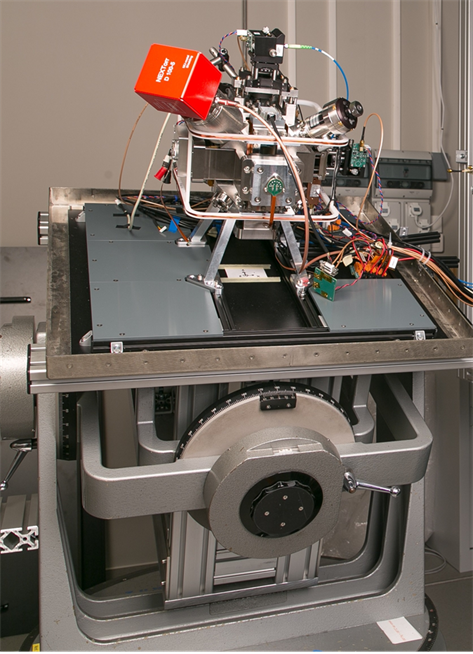The iXAtom joint laboratory aims to develop a new generation of inertial sensors, based on the use of cold atoms.
Navigating a boat or submarine imposes constraints that are not fully met by current tools. The iXAtom joint laboratory aims to develop a solution overcoming these limitations, using cold atom quantum inertial sensors.
The Quantum Day in Nouvelle-Aquitaine, organized on July 11, 2023 by the NAQUIDIS Center, was marked by the signing of the renewal of the iXAtom joint laboratory. This collaboration, which began in 2017, brings together the Laboratoire Photonique, Numérique et Nanosciences (LP2N) – associating the Institut d’Optique Graduate School, the University of Bordeaux and the CNRS – and Exail – the result of a merger between iXblue and ECA Group. The aim is to develop a new generation of inertial sensors, based on the use of cold atoms. This technological innovation could significantly improve on-board positioning and navigation systems, particularly in maritime transport. Here’s how it works.
The limits of classic inertial sensors and GPS
An inertial sensor is an instrument used to measure acceleration – an accelerometer – or rotation speed – a gyrometer. These sensors are now widely used, including in our smartphones. They are also used for more critical applications, such as boat or submarine navigation, via inertial units, which combine three accelerometers and three gyrometers.
“The problem is that these inertial sensors drift over time,” notes Vincent Ménoret, R&D manager at Exail and co-director of iXAtom. “For example, accelerometers are generally based on a system similar to a mass suspended from a spring, which elongates as a function of the acceleration experienced. However, these deformations also depend on a large number of external factors such as temperature or pressure…”. These variations can lead to errors, which are then amplified by the mathematical operations required to go from acceleration to position, up to several hundred meters after an hour’s travel.
How can these inaccuracies be corrected, without having to recalibrate the measuring equipment? The solution often chosen is to couple inertial units to GPS systems. “However, the satellite signal is not always available, for example underwater,” points out Baptiste Battelier, research engineer at the LP2N laboratory and director of iXAtom. “And some organizations may be resistant to the idea of communicating with the outside world or depending on a GPS signal.”
Cold atom quantum sensors
The joint laboratory favors the option of an autonomous navigation system, using quantum inertial sensors. Their principle: to study cold atoms in free fall, within a vacuum enclosure. “The atom has several advantages,” explains Baptiste Battelier. “Firstly, it’s easy to manipulate with lasers, for measurement purposes. And, thanks to our in-depth knowledge of its structure and fundamental properties, we can deduce information about the acceleration it undergoes. What’s more, its free-fall behavior remains the same anywhere in the world, at any time.” Quantum sensors therefore theoretically offer absolute measurements, immune to potential drift.
But what’s the point of cooling these atoms? “Cooling helps us to limit the expansion of the cloud of atoms, so as to confine it to a restricted space, where we apply our laser beam,” continues the iXAtom director. “This allows us to carry out longer measurements, and therefore achieve greater sensitivity.”
Quantum-classical hybridization
All in all, quantum inertial sensors are proving to be more accurate, sensitive and stable than their conventional counterparts. Is this enough to replace them once and for all? “Quantum sensors also have their limitations,” says Vincent Ménoret, “for example, the need to cool the atoms means that they cannot measure at certain times. Similarly, very high accelerations can exceed measurement dynamics.”
The iXAtom team therefore decided to combine the two technologies, in order to compensate for the limitations of each. The first phase of the collaboration, between 2017 and 2021, thus led to the construction of a three-axis cold atom accelerometer, the fruit of a hybridization between quantum and classical inertial sensors, which could be used in maritime or air transport, but also in other fields such as the defense industry or geophysics. This research has already been the subject of five patents and four scientific publications, and has led to the hiring of a PhD student and a postdoctoral fellow by Exail. “But we don’t intend to stop there,” says Baptiste Battelier. “First of all, we realized that high turnover was making our system ineffective. So we’re working on ways to compensate for these effects. We also want our system to be able to be taken on board a boat, which means further improving our performance and continuing our engineering work to make it sufficiently compact. These are just some of the issues on which researchers will be working during this second phase, which will culminate in the signing of the joint laboratory renewal agreement.
Image: sensor head on the rotation platform, enabling measurements to be taken in arbitrary directions and the device to be rotated.
Credit : iXAtom
CNRS link : https://entreprise.cnrs.fr/actualite/ixatom-des-capteurs-quantiques-pour-naviguer-sur-et-sous-leau/
Author: Bastien Contreras with DeepL traduction.





